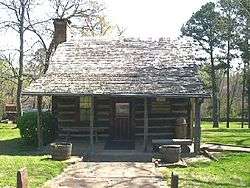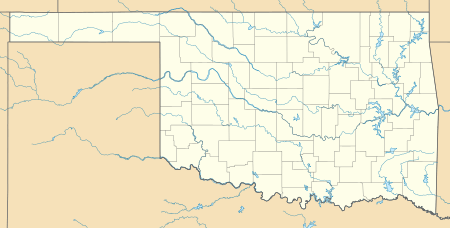Sequoyah's Cabin
Sequoyah's Cabin is a historic log cabin and historic site off Oklahoma State Highway 101 near Akins, Oklahoma. It was the home between 1829 and 1844 of the Cherokee Indian Sequoyah (also known as George Gist, c. 1765-1844), who in 1821 created a written language for the Cherokee Nation. The cabin and surrounding park, now owned by the Cherokee Nation, was declared a National Historic Landmark in 1965.[1][3]
Sequoyah's Cabin | |
 A reproduction of the cabin standing outside the protective shelter | |
  | |
| Nearest city | Akins, Oklahoma |
|---|---|
| Coordinates | 35°30′51″N 94°39′07″W |
| Area | 10 acres (4.0 ha)[1] |
| Built | 1829 |
| Architect | Sequoyah |
| NRHP reference No. | 66000634 |
| Significant dates | |
| Added to NRHP | October 15, 1966[2] |
| Designated NHL | December 21, 1965[3] |
Description
Sequoyah's Cabin is located east of Akin on the east side of OK 101 at a point where it makes a northward jog. The cabin itself is a single-story log structure with a gabled roof, on 10 acres (4.0 ha) of land that has a park-like setting. The cabin is now sheltered from the elements by a brick structure built in the 1930s. There is a bronze statue of Sequoyah outside. The house is maintained as a historic house museum and is furnished to appear as it might have when Sequoyah lived there. There are relics and documents associated with his life.
History
Sequoyah was born sometime in the 1760s to a Cherokee mother and a white or half-breed father, on the ancestral lands of the Cherokee in the southeastern United States. Unschooled except in tribal ways and customs, he came to understand the value of writing, especially in dealing with adjacent British settlers. In 1809 he began to work on a writing system for the Cherokee language. The result of his work, the Cherokee syllabary, continues to be used today. In the 1820s he moved west, to instruct western Cherokees in the writing system. It is during this period that this cabin was built, in 1829.[1]
The cabin was acquired by the Oklahoma Historical Society in 1936.[4] The shelter over the building was built by the Works Progress Administration in 1936, and is surrounded by a 10-acre (40,000 m2) park.[5][6]
In 2016, Cherokee Nation purchased the cabin and its property for $100,000.[7]
See also
References
- Joseph Scott Mendinghall (December 9, 1975). "National Register of Historic Places Inventory-Nomination: Sequoyah's Cabin" (pdf). National Park Service. Cite journal requires
|journal=(help) and Accompanying 4 photos from 1975. (1.11 MB) - "National Register Information System". National Register of Historic Places. National Park Service. January 23, 2007.
- "Sequoyah's Cabin". National Historic Landmark summary listing. National Park Service. Archived from the original on 2009-12-14. Retrieved 2008-01-20.
- "Sequoyah's Cabin," Oklahoma Historical Society. Accessed September 2, 2016.
- http://www.exploresouthernhistory.com/oksequoyah.html Explore Southern History: Sequoyah's Cabin
- http://www.travelok.com/toDo/attractionsDetail.asp?id=1+5U+7230 Travel Oklahoma
- "Cherokees purchase Sequoyah’s Cabin," Sequoyah County Times, September 2, 2016. Accessed September 2, 2016.
External links
- Sequoyah's Cabin on TravelOK.com Official travel and tourism website for the State of Oklahoma
- National Park Service article on Sequoyah's Cabin
- Photos
- Sequoyah's Cabin State Park